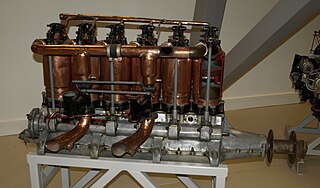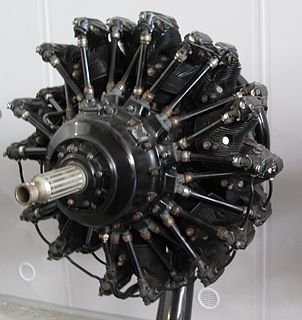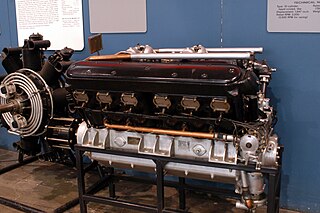
The Isotta Fraschini V.4 of 1916 was an Italian six-cylinder, water-cooled, in-line piston aero engine of World War I. Its construction was fairly typical of aircraft engines of the period with six cast-iron cylinders mounted in pairs with common heads. This engine was also produced by Alfa Romeo.

The Turbomeca Aubisque was a small turbofan engine designed and produced by Turbomeca in the 1960s. Its only application was the Saab 105 military trainer aircraft as the RM9. The engine is named after the Col d'Aubisque in the Pyrenees mountains, in line with company tradition.

The BMW 114 was a nine-cylinder air-cooled radial engine intended for military aircraft use. Developed in 1935 from the BMW 132, with which it could be interchanged, work did not progress beyond experimental prototype engines.
The RAF 2 was a British air-cooled, nine-cylinder radial engine developed for aircraft use just prior to World War I; it was designed and built by the Royal Aircraft Factory.

The Beardmore 120 hp was a British six-cylinder, water-cooled aero engine that first ran in 1914, it was built by William Beardmore and Company as a licensed-built version of the Austro-Daimler 6. The engine featured cast iron cylinders and mild steel concave pistons. Produced between August 1914 and December 1918, the design powered many World War I aircraft types.

The Beardmore 160 hp is a British six-cylinder, water-cooled aero engine that first ran in 1916, it was built by Arrol-Johnston and Crossley Motors for William Beardmore and Company as a development of the Beardmore 120 hp, itself a licensed-built version of the Austro-Daimler 6.
The Fiat AS.5 was an Italian 12-cylinder, liquid-cooled V engine designed and built in the late-1920s by Fiat especially for the 1929 Schneider Trophy air race.

The Green E.6 was a British six-cylinder, water-cooled aero engine that first ran in 1911, it was designed by Gustavus Green and built by the Green Engine Co and Mirlees, Bickerton & Day of Stockport between August 1914 and December 1918.

The Walter Mars was a Czechoslovakian 14-cylinder, air-cooled radial engine for powering aircraft, a licensed built Gnome-Rhône 14M.

The Klimov TV2-117 is a Soviet gas-turbine turboshaft engine intended for helicopter use. Designed in the early 1960s by the Isotov Design Bureau the engine became the first purpose built gas turbine engine for helicopter use by the Soviet Union with previous helicopter turbines being adapted aeroplane powerplants. It was later produced by Klimov, production ending in 1997.

The Isotta Fraschini V.6 was an Italian six-cylinder, water-cooled, in-line piston aero engine of the late World War I period, the "V" denoted "Volo" or "flight". Its construction was fairly typical of contemporary aircraft engines, using six cast-iron cylinders mounted in pairs with common heads.

The Wright T-3 Tornado, also given the USAF designation Wright V-1950 was an American liquid-cooled aircraft piston engine, designed in the early 1920s.

The Walter NZ 120 was a nine-cylinder, air-cooled, radial engine for aircraft use built in Czechoslovakia by Walter Aircraft Engines in the 1920s. Using common cylinders and parts from the NZ (Novák-Zeithammer) range of engines the NZ 120 produced up to 135 horsepower (99 kW).

The Fiat A.30 R.A. was an Italian water-cooled aircraft engine from the 1920s, built in large numbers and serving with several air forces up to the beginning of World War II. It produced 447 kW (600 hp).

The Fiat A.25 was an Italian water-cooled aircraft engine from the 1920s. It produced 708 kW (950 hp) and was used by the Regia Aeronautica for fifteen years to power their Fiat BR.2 and BR.3 bombers.

The Fiat AN.1 was an experimental Italian water-cooled diesel straight six cylinder aircraft engine from the late 1920s.
The Franklin O-500 was an American air-cooled aircraft engine that first ran in the mid-1940s. The engine was of six-cylinder, horizontally-opposed layout and displaced 500 cu in (8 L). The power output was 215 hp (160 kW).

The Farman 12We was a French 12-cylinder broad arrow configuration aircraft engine that was designed and built by Farman in the early 1920s. Power output was 370 kilowatts (500 hp).

The Fiat A.60 was a four-cylinder, air-cooled inline engine developed in Italy in the 1930s.

The Walter NZ 85 was a seven-cylinder, air-cooled, radial engine for aircraft use built in Czechoslovakia by Walter Aircraft Engines in the late-1920s.

















